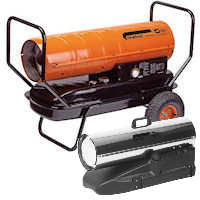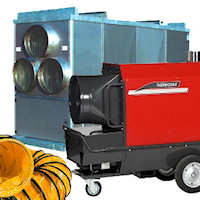FINANCE AVAILABLE (£1000 minimum)
Indirect Diesel Heaters
An Indirect space heater is suitable for marquee heating, or any other area where clean, fume free warm air is required. Indirect heaters have a heat exchanger keeping combustion fumes seperate from the heated air. If the heater is sited outside, the warm air is normally ducted into the building or marquee. If sited indoors a flue or chimney is required to expel the exhaust fumes.
| |
| |
| |
| |
| |
For small direct fired kerosene or diesel space heaters suitable for garages and workshops
see
Diesel Space Heaters
For large portable diesel heaters suitable for exhibition halls, or large constuction sites, we have containerised and wheeled heaters which are supplied by bulk fuel tanks.
see
Portable Industrial Diesel Heaters
Diesel Heater Guide
Kerosene Fuel
Kerosene is also known as Class C2 oil fuel, or 28 sec oil fuel. Where flue pipes are fitted to a heater, they have to be rated for 250 deg C (T250 rating).
Diesel Fuel
Diesel for heating is also known as Class D oil fuel, Gas Oil, 35 sec oil fuel, or Red Diesel. Where flue pipes are fitted to a heater, they have to be rated for 400 deg C (T400 rating).
Radiant Infrared Space Heaters
These popular garage heaters use diesel to heat up a large metal plate until it glows orange, radiating heat like the sun.
Portable Space Heaters
Small portable diesel heaters normally have fuel tanks, whilst large heaters usually have to be connected to a seperate fuel tank.
Direct or Indirect Heating ?
Most portable diesel heaters are direct fired, i.e. the fan blows heat directly from the flame. Indirect fired heaters are more expensive as they have a heat exchanger and a flue. The heated air is fume free, whilst exhaust gases go up the flue.
Axial or Radial Fan ?
Most portable space heaters have axial fans. For large air flows, and especially along long ducts, radial fans (centrifugal fans) are recommended. For fans with large air flow, three-phase (400V) electricity is required.




388